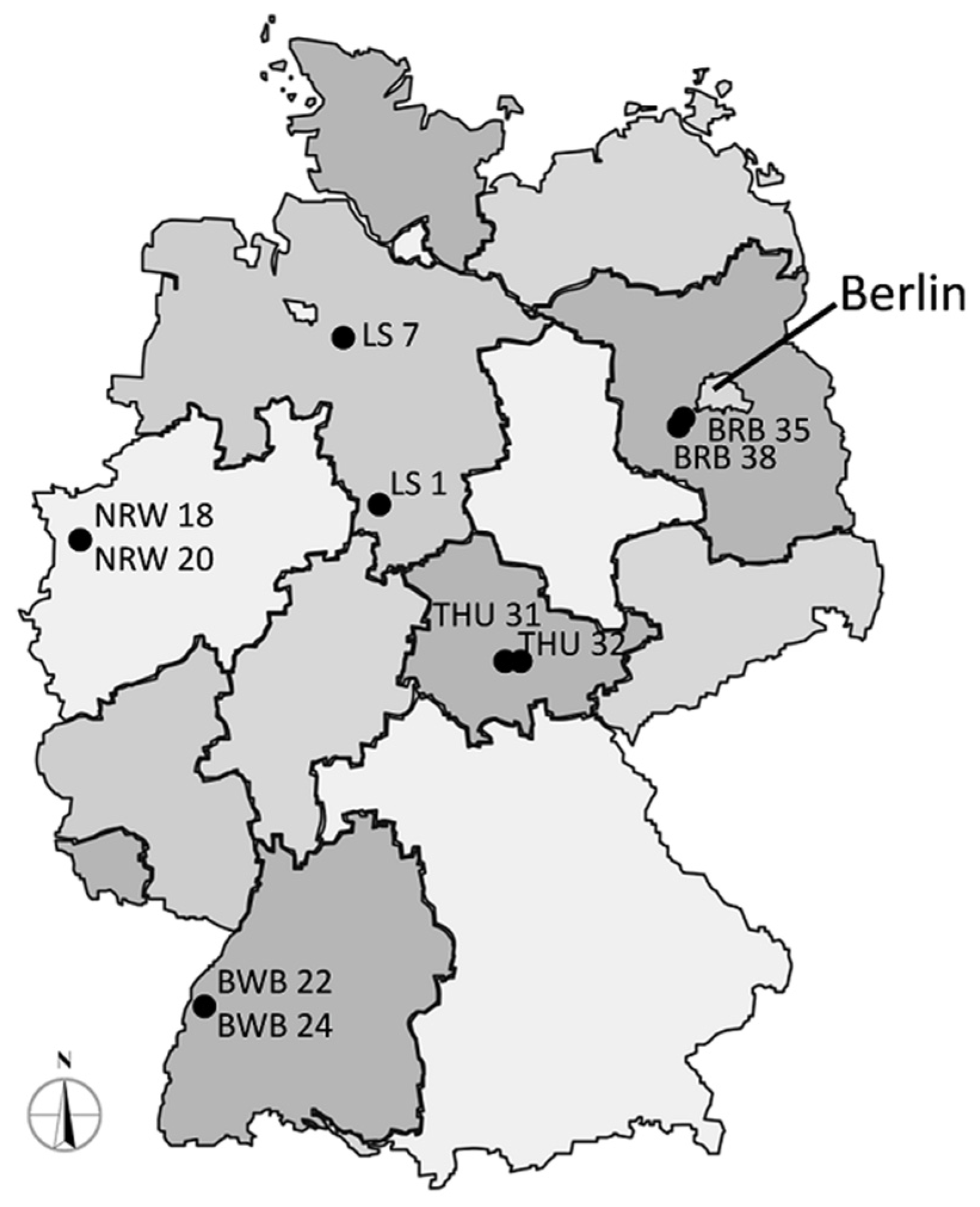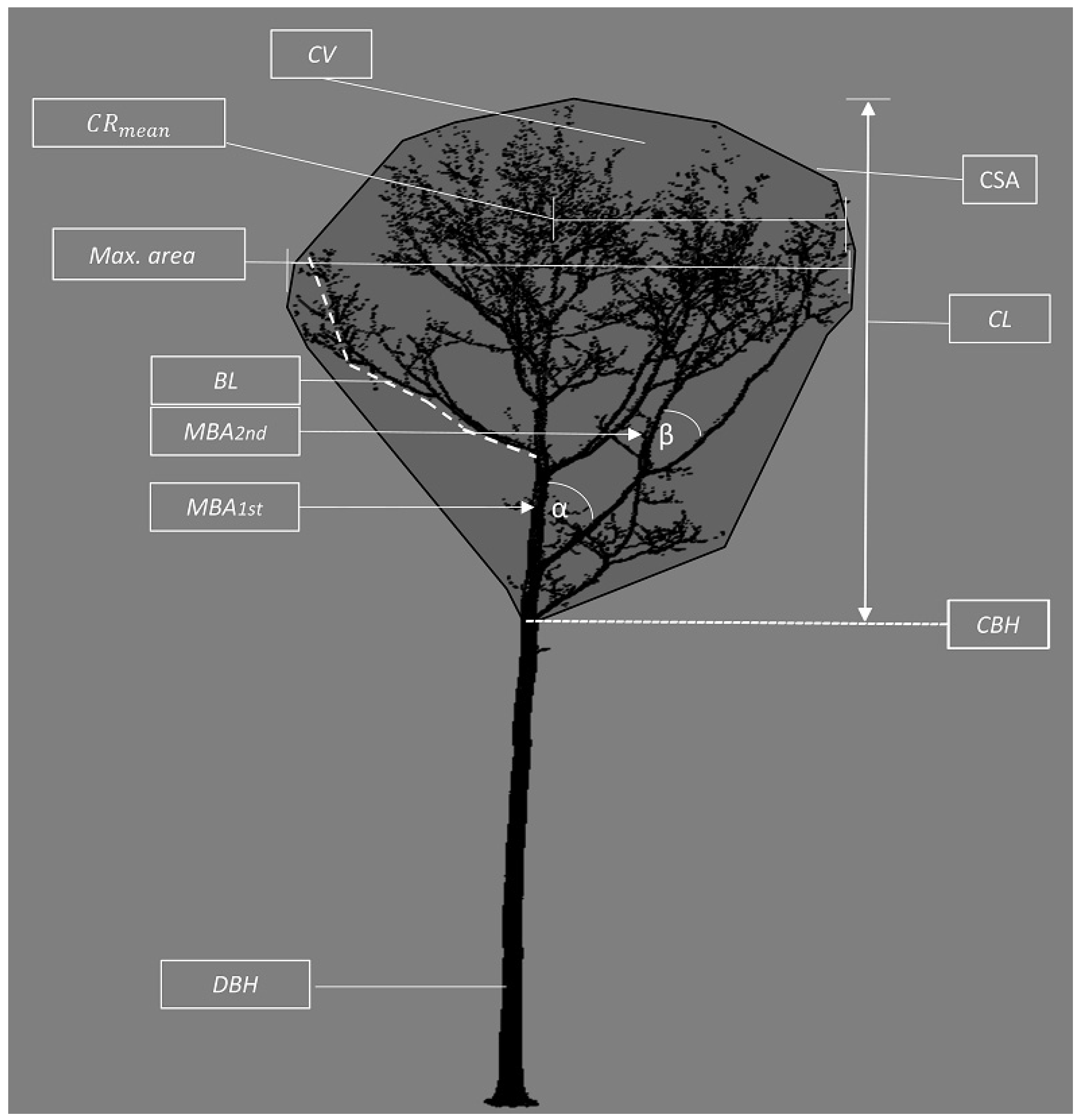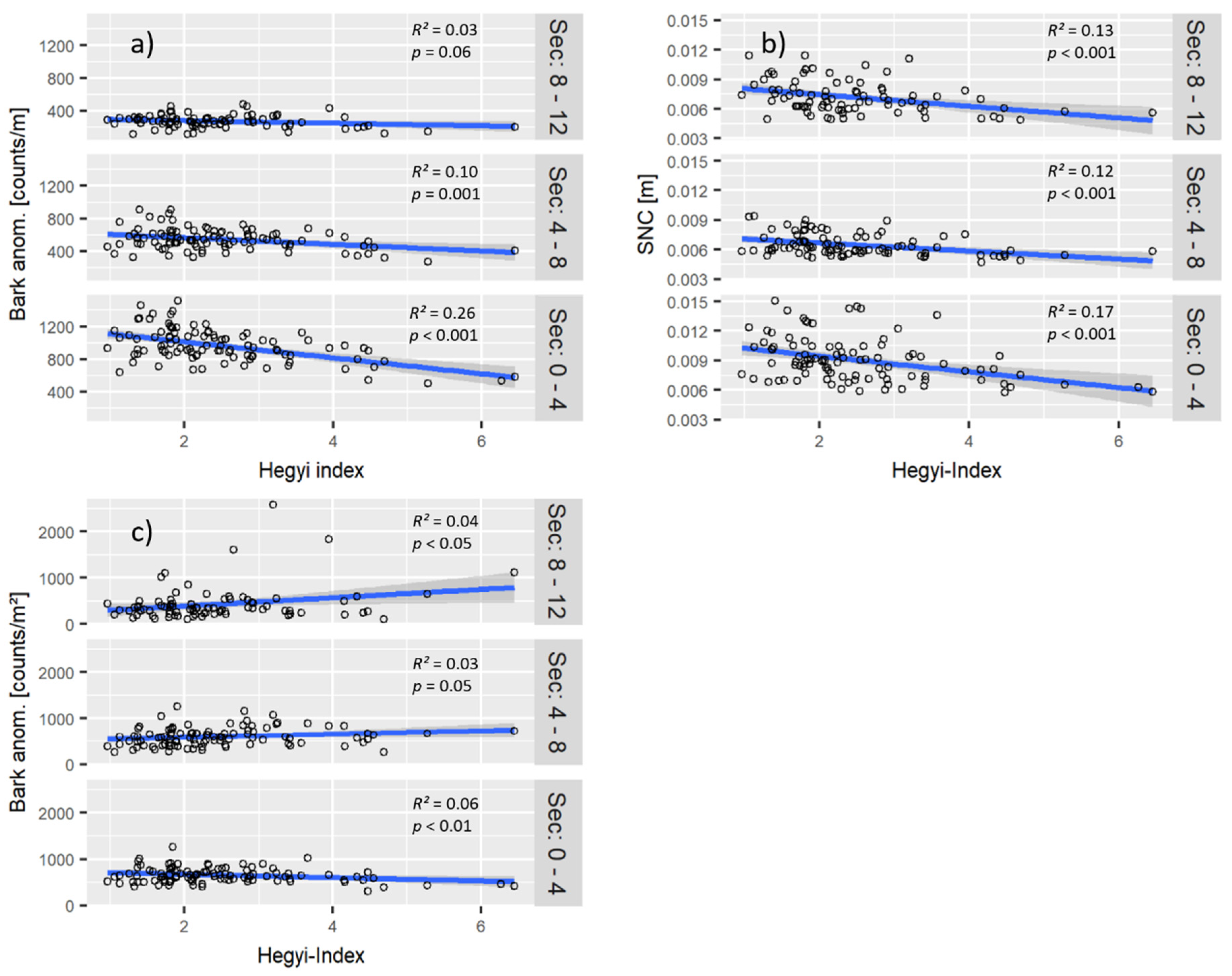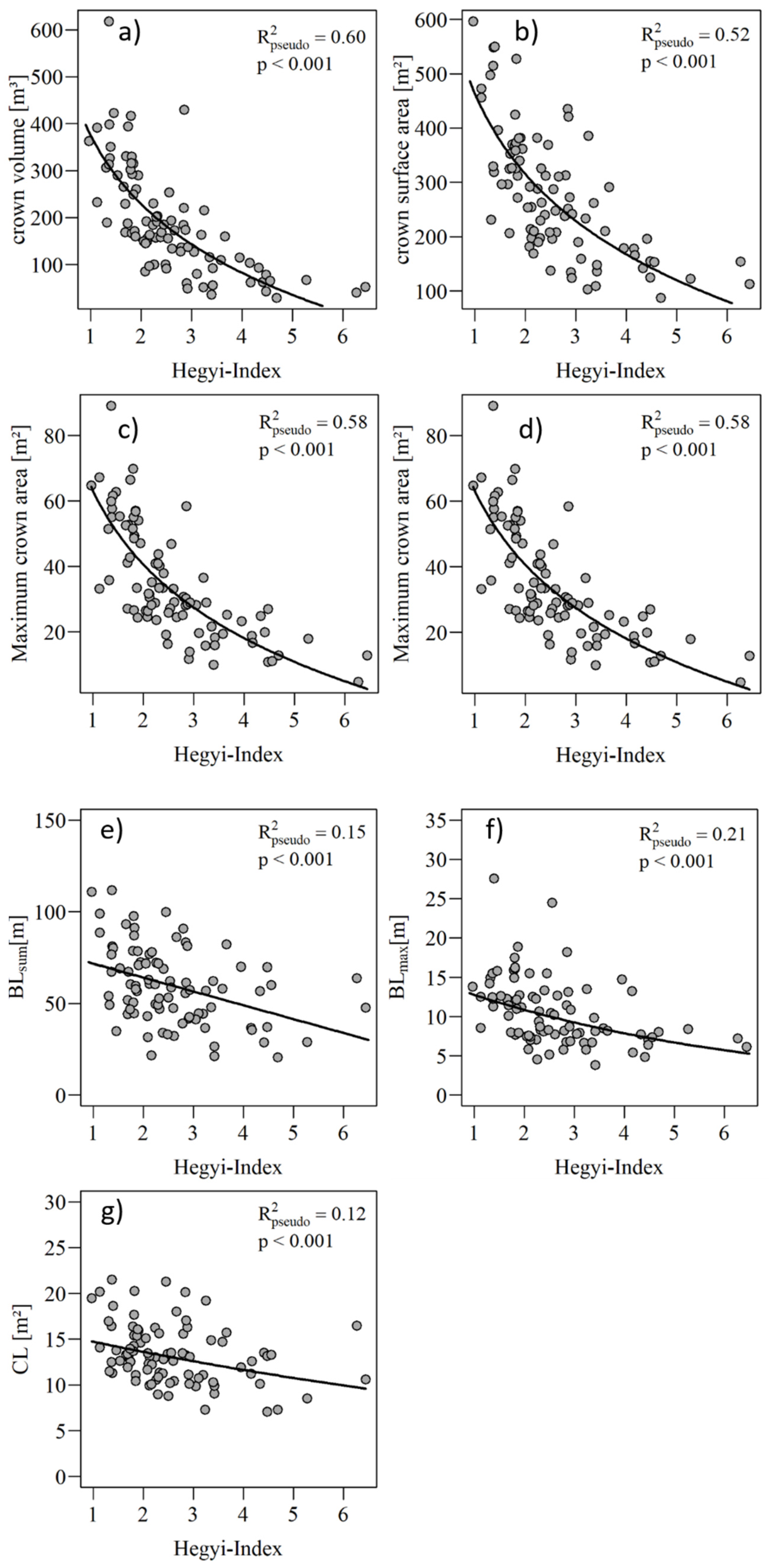Intraspecific Competition Affects Crown and Stem Characteristics of Non-Native Quercus rubra L. Stands in Germany
Abstract
1. Introduction
2. Materials and Methods
2.1. Study Sites
2.2. Tree Inventory
2.3. Terrestrial Laserscanning
2.4. Post-processing of TLS Data
2.4.1. Timber Quality Assessment
2.4.2. Tree Architecture
2.4.3. Tree Morphology
2.5. Statistical Analysis
3. Results
4. Discussion
4.1. Effect of Competition Intensity on Crown Attributes
4.2. Effect of Competition Intensity on Stem Quality Characteristics
4.3. Effect of Site Conditions
4.4. Silvicultural Recommendations
5. Conclusions
Supplementary Materials
Author Contributions
Funding
Acknowledgments
Conflicts of Interest
References
- Cotta, H. Anweisung zum Waldbau; Arnoldische Buchhandlung: Leipzig, Germany, 1828. [Google Scholar]
- Bernhardt, A. Geschichte des Waldeigenthums, der Waldwirthschaft und Forstwissenschaft in Deutschland; Springer: Berlin, Germany, 1874. [Google Scholar]
- Kraft, G. Beiträge zur Lehre von den Durchforstungen, Schlagstellungen und Lichtungshieben; Klindworth’s: Hannover, Germany, 1884. [Google Scholar]
- Burschel, P.; Huss, J. Grundriss des Waldbaus. Ein Leitfaden für Studium und Praxis; Eugen Ulmer: Stuttgart (Hohenheim), Germany, 2003; ISBN 3800145707. [Google Scholar]
- Eisenhauer, D.R.; Sonnemann, S. Waldbaustrategien unter sich ändernden Umweltbedingungen–Leitbilder, Zielsystem und Waldentwicklungstypen. Wald. Landsch. Nat. 2009, 8, 71–88. [Google Scholar]
- Kölling, C. Nichtheimische Baumarten—Alternativen im klimagerechten Waldumbau? LWF Aktuell 2013, 96, 4–11. [Google Scholar]
- Stratmann, J.; Warth, H. Die Roteiche als Alternative zur Eiche oder Buche in Nordwestdeutschland. Allg. Forstz. 1987, 42, 40–41. [Google Scholar]
- Schmitz, F.; Polley, H.; Hennig, P.; Kroiher, F.; Marks, A.; Riedel, T.; Schmidt, U.; Schwitzgebel, F.; Stauber, T. Der Wald in Deutschland. Ausgewählte Ergebnisse der dritten Bundeswaldinventur. Bonn. 2014. Available online: https://www.bundeswaldinventur.de/fileadmin/SITE_MASTER/content/Dokumente/Downloads/BMEL_Wald_Broschuere.pdf (accessed on 21 May 2018).
- Sander, I.L. Quercus rubra L. Northern Red Oak. In Silvics of North America: 1. Conifers; 2. Hardwoods: Agricultural Handbook 654; Burns, R.M., Honkala, B.H., Eds.; Technical Coordinators; USDA, Forest Service: Washington, DC, USA, 1990; pp. 727–733. [Google Scholar]
- Leibundgut, H. Über die waldbauliche Behandlung der Eiche. Schweiz. Zeits. Forstwes. 1945, 96, 49–58. [Google Scholar]
- Mosandl, R.; Kateb, H.; Ecker, J. Untersuchungen zur Behandlung von jungen Eichenbeständen. Forstw. Cbl. 1991, 110, 358–370. [Google Scholar] [CrossRef]
- Block, J.; Schuck, J.; Seifert, T. Einfluss der waldbaulichen Behandlung und der Holznutzung auf den Nährstoffhaushalt von Traubeneichenökosystemen. In Eiche im Pfälzerwald: Publications of the Research Institute of Forest Ecology and Forestry Rhineland-Palatinate; Dong, P.H., Ed.; Research Institute for Forest Ecology and Forestry Rhineland-Palatinate: Palatinate, Germany, 2007; pp. 117–150. [Google Scholar]
- Sondermann. Changes in Hardwood Growing-Stock Tree Grades; Research Paper NE-608; US Department of Agriculture, Forest Service, Northeastern Forest Experiment Station: Broomall, PA, USA, 1987; p. 608.
- Dey, D.C.; Parker, W.C. Regeneration of Red Oak (Quercus Rubra L.) Using Shelterwood Systems: Ecophysiology, Silviculture and Management Recommandations; Forest Research Information Report No. 59; Ontario Forest Research Institute: Ontario, CA, USA, 1996; ISBN 0-7778-4863-5. [Google Scholar]
- Dey, D.C.; Royo, A.A.; Brose, P.H.; Hutchinson, T.F.; Spetich, M.A.; Stoleson, S.H. An ecologically based approach to oak silviculture_A synthesis of 50 years of oak ecosystem research in North America. Rev. Colomb. For. 2010, 13, 201–222. [Google Scholar]
- Du Cros, E.T. The french approach to broadleaved silviculture. Ir. For. 1987, 44, 116–126. [Google Scholar]
- Rédei, K.; Csiha, I.; Keserû, Z.; Rásó, J.; Gyôri, J. Management of red oak (Quercus rubra L.) stands in the Nyírség forest region (Eastern-Hungary). Hung. Agric. Res. 2010, 3, 13–17. [Google Scholar]
- Klemmt, H.-J.; Neubert, M.; Falk, W. Das Wachstum der Roteiche im Ver- gleich zu den einheimischen Eichen. LWF Aktuell 2013, 97, 28–31. [Google Scholar]
- Bauer, F. Die Roteiche; JD Sauerländer’s Vertrag: Frankfurt, Germany, 1953. [Google Scholar]
- Göhre, K.; Wagenknecht, E. Die Roteiche und ihr Holz; Deutscher Bauernverlag: Berlin, Germany, 1955. [Google Scholar]
- Seidel, J.; Kenk, G. Wachstum und Wertleistung der Eichenarten in Baden-Württemberg. AFZ-Der Wald 2003, 1, 28–31. [Google Scholar]
- Nagel, R. Roteiche Quercus rubra L. In Potenziale und Risiken eingeführter Baumarten; Vor, T., Spellmann, H., Bolte, A., Ammer, C., Eds.; Universitätsverlag Göttingen: Göttingen, Germany, 2015; pp. 219–267. ISBN 9783863952402. [Google Scholar]
- Watt, P.J.; Donoghue, D.N.M. Measuring forest structure with terrestrial laser scanning. Int. J. Remote Sens. 2007, 26, 1437–1446. [Google Scholar] [CrossRef]
- Newnham, G.J.; Armston, J.D.; Calders, K.; Disney, M.I.; Lovell, J.L.; Schaaf, C.B.; Strahler, A.H.; Danson, F.M. Terrestrial Laser Scanning for Plot-Scale Forest Measurement. Curr. For. Rep. 2015, 1, 239–251. [Google Scholar] [CrossRef]
- Seidel, D. A holistic approach to determine tree structural complexity based on laser scanning data and fractal analysis. Ecol. Evol. 2018, 8, 128–134. [Google Scholar] [CrossRef] [PubMed]
- Seidel, D.; Ehbrecht, M.; Dorji, Y.; Jambay, J.; Ammer, C.; Annighöfer, P. Identifying architectural characteristics that determine tree structural complexity. Trees 2019, 33, 911–919. [Google Scholar] [CrossRef]
- Höwler, K.; Annighöfer, P.; Ammer, C.; Seidel, D. Competition improves quality-related external stem characteristics of Fagus sylvatica. Can. J. For. Res. 2017, 47, 1603–1613. [Google Scholar] [CrossRef]
- Simonse, M.; Aschoff, T.; Spiecker, H.; Thies, M. Automatic determination of forest inventory parameters using terrestrial laser scanning. In Proceedings of the Scandlaser Scientific Workshop on Airborne Laser Scanning of Forests; Hyyppä, J., Nesset, E., Olsson, H., Granqvist Pahlén, T., Reese, H., Eds.; Department of Forest Resource Management and Geomatics, Swedish University of Agricultural Sciences: Umeá, Sweden, 2003; pp. 252–258. [Google Scholar]
- Hopkinson, C.; Chasmer, L.; Young-Pow, C.; Treitz, P. Assessing forest metrics with a ground-based scanning lidar. Can. J. For. Res. 2004, 34, 573–583. [Google Scholar] [CrossRef]
- Seidel, D.; Schall, P.; Gille, M.; Ammer, C. Relationship between tree growth and physical dimensions of Fagus sylvatica crowns assessed from terrestrial laser scanning. iForest 2015, 8, 735–742. [Google Scholar] [CrossRef]
- Raumonen, P.; Kaasalainen, M.; Åkerblom, M.; Kaasalainen, S.; Kaartinen, H.; Vastaranta, M.; Holopainen, M.; Disney, M.; Lewis, P. Fast Automatic Precision Tree Models from Terrestrial Laser Scanner Data. Remote Sens. 2013, 5, 491–520. [Google Scholar] [CrossRef]
- Kretschmer, U.; Kirchner, N.; Morhart, C.; Spiecker, H. A new approach to assessing tree stem quality characteristics using terrestrial laser scans. Silva Fenn. 2013, 47, 1071. [Google Scholar] [CrossRef]
- Höwler, K.; Vor, T.; Seidel, D.; Annighöfer, P.; Ammer, C. Analyzing effects of intra- and interspecific competition on timber quality attributes of Fagus sylvatica L.—From quality assessments on standing trees to sawn boards. Eur. J. For. Res. 2019, 138, 327–343. [Google Scholar] [CrossRef]
- Seidel, D.; Leuschner, C.; Müller, A.; Krause, B. Crown plasticity in mixed forests—Quantifying asymmetry as a measure of competition using terrestrial laser scanning. For. Ecol. Manag. 2011, 261, 2123–2132. [Google Scholar] [CrossRef]
- Bayer, D.; Seifert, S.; Pretzsch, H. Structural crown properties of Norway spruce (Picea abies [L.] Karst.) and European beech (Fagus sylvatica [L.]) in mixed versus pure stands revealed by terrestrial laser scanning. Trees 2013, 27, 1035–1047. [Google Scholar] [CrossRef]
- Metz, J.; Seidel, D.; Schall, P.; Scheffer, D.; Schulze, E.-D.; Ammer, C. Crown modeling by terrestrial laser scanning as an approach to assess the effect of aboveground intra- and interspecific competition on tree growth. For. Ecol. Manag. 2013, 310, 275–288. [Google Scholar] [CrossRef]
- Juchheim, J.; Annighöfer, P.; Ammer, C.; Calders, K.; Raumonen, P.; Seidel, D. How management intensity and neighborhood composition affect the structure of beech (Fagus sylvatica L.) trees. Trees 2017, 31, 1723–1735. [Google Scholar] [CrossRef]
- Pettenkofer, T.; Burkardt, K.; Ammer, C.; Vor, T.; Finkeldey, R.; Müller, M.; Krutovsky, K.; Vornam, B.; Leinemann, L.; Gailing, O. Genetic diversity and differentiation of introduced red oak (Quercus rubra) in Germany in comparison with reference native North American populations. Eur. J. For. Res. 2019, 138, 275–285. [Google Scholar] [CrossRef]
- DWD Climate Data Center (CDC). Jahressumme der Raster der monatlichen Niederschlagshöhe für Deutschland unter Berücksichtigung der Klimatologie. 1988–2018. Available online: https://opendata.dwd.de/climate_environment/CDC/grids_germany/annual/precipitation/ (accessed on 27 September 2019).
- DWD Climate Data Center (CDC). Jahresmittel der Raster der monatlich gemittelten Lufttemperatur (2m) für Deutschland. 1988–2018. Available online: https://opendata.dwd.de/climate_environment/CDC/grids_germany/annual/air_temperature_mean/ (accessed on 27 August 2019).
- DWD Climate Data Center (CDC). Jährliche Raster von Stiel-Eiche-Herbstliche Blattverfärbung in Deutschland. 1992–2018, Version 0.x. Available online: https://opendata.dwd.de/climate_environment/CDC/grids_germany/annual/phenology/STEBV/ (accessed on 27 September 2019).
- DWD Climate Data Center (CDC). Jährliche Raster von Stiel-Eiche-Beginn der Blattentfaltung in Deutschland. 1992–2018, Version 0.x. Available online: https://opendata.dwd.de/climate_environment/CDC/grids_germany/annual/phenology/STEBO/ (accessed on 27 September 2019).
- Hegyi, F. A simulation model for managing jack-pine stands. In Growth Models for Tree and Stand Simulations; Fries, J., Ed.; Royal College of Forest: Stockholm, Sweden, 1974; pp. 74–90. [Google Scholar]
- Van der Zande, D.; Jonckheere, I.; Stuckens, J.; Verstraeten, W.W.; Coppin, P. Sampling design of ground-based lidar measurements of forest canopy structure and its effect on shadowing. Can. J. Remote Sens. 2014, 34, 526–538. [Google Scholar] [CrossRef]
- Seidel, D.; Ammer, C. Efficient measurements of basal area in short rotation forests based on terrestrial laser scanning under special consideration of shadowing. iForest 2014, 7, 227–232. [Google Scholar] [CrossRef]
- Piboule, A., Krebs, M., Esclatine, L., Hervé, J.-C., Eds.; Computree: A Collaborative Platform for Use of Terrestrial Lidar in Dendrometry. In Proceedings of the International IUFRO Conference MeMoWood, Nancy, France, 1–4 October 2013. [Google Scholar]
- Hackenberg, J.; Spiecker, H.; Calders, K.; Disney, M.; Raumonen, P. SimpleTree—An Efficient Open Source Tool to Build Tree Models from TLS Clouds. Forests 2015, 6, 4245–4294. [Google Scholar] [CrossRef]
- R Core Team. R: A Language and Environment for Statistical Computing; R Foundation for Statistical Computing: Vienna, Austria, 2018. [Google Scholar]
- Wasserstein, R.L.; Schirm, A.L.; Lazar, N.A. Moving to a World Beyond “p < 0.05”. Am. Stat. 2019, 73, 1–19. [Google Scholar] [CrossRef]
- Roloff, A. Baumkronen. Verständnis und Praktische Bedeutung eines Komplexen Naturphänomens; Eugen Ulmer: Stuttgart, Germany, 2001. [Google Scholar]
- Purves, D.W.; Lichstein, J.W.; Pacala, S.W. Crown plasticity and competition for canopy space: A new spatially implicit model parameterized for 250 North American tree species. PLoS ONE 2007, 2, e870. [Google Scholar] [CrossRef] [PubMed]
- Thorpe, H.C.; Astrup, R.; Trowbridge, A.; Coates, K.D. Competition and tree crowns: A neighborhood analysis of three boreal tree species. For. Ecol. Manag. 2010, 259, 1586–1596. [Google Scholar] [CrossRef]
- Dieler, J.; Pretzsch, H. Morphological plasticity of European beech (Fagus sylvatica L.) in pure and mixed-species stands. For. Ecol. Manag. 2013, 295, 97–108. [Google Scholar] [CrossRef]
- Mäkinen, H.; Hein, S. Effect of wide spacing on increment and branch properties of young Norway spruce. Eur. J. For. Res. 2006, 125, 239–248. [Google Scholar] [CrossRef]
- Pretzsch, H.; Schütze, G. Crown allometry and growing space efficiency of Norway spruce (Picea abies L. Karst.) and European beech (Fagus sylvatica L.) in pure and mixed stands. Plant Biol. (Stuttg.) 2005, 7, 628–639. [Google Scholar] [CrossRef] [PubMed]
- Brown, P.L.; Doley, D.; Keenan, R.J. Stem and crown dimensions as predictors of thinning responses in a crowded tropical rainforest plantation of Flindersia brayleyana F. Muell. For. Ecol. Manag. 2004, 196, 379–392. [Google Scholar] [CrossRef]
- Lang, A.C.; Härdtle, W.; Bruelheide, H.; Geißler, C.; Nadrowski, K.; Schuldt, A.; Yu, M.; von Oheimb, G. Tree morphology responds to neighbourhood competition and slope in species-rich forests of subtropical China. For. Ecol. Manag. 2010, 260, 1708–1715. [Google Scholar] [CrossRef]
- Mäkelä, A.; Vanninen, P. Impacts of size and competition on tree form and distribution of aboveground biomass in Scots pine. Can. J. For. Res. 1998, 28, 216–227. [Google Scholar] [CrossRef]
- Prescott, C.E. The influence of the forest canopy on nutrient cycling. Tree Physiol. 2002, 22, 1193–1200. [Google Scholar] [CrossRef]
- Hardiman, B.S.; Gough, C.M.; Halperin, A.; Hofmeister, K.L.; Nave, L.E.; Bohrer, G.; Curtis, P.S. Maintaining high rates of carbon storage in old forests: A mechanism linking canopy structure to forest function. For. Ecol. Manag. 2013, 298, 111–119. [Google Scholar] [CrossRef]
- Jucker, T.; Bouriaud, O.; Coomes, D.A.; Baltzer, J. Crown plasticity enables trees to optimize canopy packing in mixed-species forests. Funct. Ecol. 2015, 29, 1078–1086. [Google Scholar] [CrossRef]
- Assmann, E. The Principles of Forest Yield Study; Pergamon Press Ltd.: Oxford, UK, 1970. [Google Scholar]
- Richter, C. Holzmerkmale Beschreibung der Merkmale, Ursachen, Vermeidung, Auswirkungen auf die Verwendung des Holzes, Technologische Anpassung; DRW: Leinfelden-Echterdingen, Germany, 2010. [Google Scholar]
- Ballard, L.A.; Long, J.N. Influence of stand density on log quality of lodgepole pine. Can. J. For. Res. 1988, 18, 911–916. [Google Scholar] [CrossRef]
- Gottschalk, K.W. Stem quality of oak in 15-year-old stands: Influence of species within harvesting treatment and fencing. In Advances in Research in Intermediate Oak Stands; Spiecker, H., Rogers, R., Somogyi, Z., Eds.; Institute for Forest Growth, Albert-Ludwigs-University of Freiburg: Freiburg, Germany, 1997; pp. 85–97. [Google Scholar]
- Mäkinen, H. Effect of stand density on radial growth of branches of Scots pine in southern and central Finland. Can. J. For. Res. 1999, 29, 1216–1224. [Google Scholar] [CrossRef]
- Mäkinen, H. Effect of stand density on the branch d, evelopment of silver birch (Betula pendula Roth) in central Finland. Trees 2002, 16, 346–353. [Google Scholar] [CrossRef]
- Sondermann, D.L. Quality Response of Even-Aged 80 Year Old White Oak Trees after Thinning; Research Paper NE-543; US Department of Agriculture, Forest Service, Northeastern Forest Experiment Station: Broomall, PA, USA, 1984; 6p.
- Maintaining Biodiversity in Forest Ecosystems; Hunter, M.L., Jr., Ed.; Cambridge University Press: New York, NY, USA, 1999. [Google Scholar]
- Fischer, H. Qualitätserziehung bei jungen Traubeneichen (Quercus petraea Liebl.) allein durch innerartlicher Konkurrenz. Forst Holz 2000, 55, 377–382. [Google Scholar]
- RVR. Rahmenvereinbarung für den Rohholzhandel in Deutschland RVR. 2015. Available online: http://www.rvr-deutschland.de/docs/dynamisch/8302/rvr_gesamtdokument_2.auflage_stand_oktober_2015.pdf (accessed on 27 May 2019).
- Schulz, H. Auswirkungen von Rückeschäden an jungen Buchen und Edellaubhölzern. Holzforschung 1973, 27, 42–47. [Google Scholar] [CrossRef]
- Hassler, C.C.; Grushecky, S.T. An Assessment of Following Timber Harvests in West Virginia. North. J. Appl. For. 1999, 16, 191–196. [Google Scholar] [CrossRef]
- Akay, A.E.; Yilmaz, M.; Tonguc, F. Impact of Mechanized Harvesting Machines on Forest Ecosystem: Residual Stand Damage. J. Appl. Sci. 2006, 6, 2414–2419. [Google Scholar]
- Seablom, T.J.; Reed, D.D. Assessment of Factors Contributing to Residual Tree Damage from Mechanized Harvesting in Northern Hardwoods. North. J. Appl. For. 2005, 22, 124–131. [Google Scholar] [CrossRef]
- Zingg, A.; Ramp, B. Wachstum und Stammqualität in reinen und gemischten Buchenbeständen. Tagungsbericht, Jahrestagung 1997 des Deutschen Verbandes Forstlicher Forschungsanstalten 2003, 152–164. [Google Scholar]
- Dean, C. Calculation of wood volume and stem taper using terrestrial single-image close-range photogrammetry and contemporary software tools. Silva Fenn. 2003, 37, 359–380. [Google Scholar] [CrossRef][Green Version]
- Bertness, M.D.; Callaway, R. Positive interactions in communities. Trends Ecol. Evol. 1994, 9, 191–193. [Google Scholar] [CrossRef]
- Maestre, F.T.; Callaway, R.M.; Valladares, F.; Lortie, C.J. Refining the stress-gradient hypothesis for competition and facilitation in plant communities. J. Ecol. 2009, 97, 199–205. [Google Scholar] [CrossRef]
- Sterba, H.; Vospernik, S.; Söderbergh, I.; Ledermann, T. Harvesting Rules and Modules for Predicting Commercial Timber Assortments. In Sustainable Forest Management: Growth Models for Europe; Hasenauer, H., Ed.; Springer: Berlin/Heidelberg, Germany, 2006; ISBN 978-3-540-31304-5. [Google Scholar]
- Sonderman, D.L.; Rast, E.D. Effect of Thinning on Mixed-Oak Stem Quality; Northeastern Forest Experiment Station: Broomall, PA, USA, 1988.




| Stand Information | LS | NRW | BWB | THU | BRB | |||||
|---|---|---|---|---|---|---|---|---|---|---|
| District | Dassel | Rotenburg | Niederrhein | Niederrhein | Offenburg | Offenburg | Neustadt | Jena-Holzland | Potsdam | Potsdam |
| Department | Sievershausen | Diensthop | Leucht | Leucht | Schutterwald | Schutterwald | Strößwitz | Wolfersdorf | Güterfelde | Güterfelde |
| PlotID | 1 | 7 | 18 | 20 | 22 | 24 | 31 | 32 | 35 | 38 |
| Area size (ha) | 1.0 | 0.9 | 0.8 | 1.3 | 0.8 | 1.0 | 1.0 | 1.1 | 1.0 | 1.0 |
| latitude | 51°46′47.34″ N | 52°56′46.74″ N | 51°32′14.11″ N | 51°32′19.68″ N | 48°27′13.11″ N | 48°27′9.64″ N | 50°45′37.95″ N | 50°46′19.90″ N | 52°27′13.29″ N | 52°22′57.95″ N |
| longitude | 9°35′25.30″ E | 9°21′58.43″ E | 6°29′26.77″ E | 6°29′50.10″ E | 7°51′32.91″ E | 7°51′37.01″ E | 11°43′31.84″ E | 11°38′27.95″ E | 13°4′37.92″ E | 13°5′43.83″ E |
| Genetic Hap. * | A | A, B, C | A, B, C | A, E, B | A, C, E, B | A, C, B | A | A, B, C | A, C, O | A, B |
| soil texture | loessic loam | loamy sand | gravelly-, loamy sand | loamy sand | silty loam | silty loam | sand | sand | sand | sandy cover layers over boulder clay |
| Last thinning intervention | 2013 | 2017 | 2017 | 2017 | 2013/2014 | 2013/2014 | 2013 | 2015 | 2014 | 2007 |
| Crown thinning (m3, * ha−1) | 33.5 | 35 | 25 | 25 | 30–40 | 30–40 | 30 | 30 | 36 | N/A |
| MPV (mm) ** | 468 | 346 | 354 | 359 | 397 | 397 | 350 | 341 | 291 | 284 |
| TMV (°C) ** | 13.6 | 15.8 | 16.9 | 16.8 | 18.0 | 18.0 | 15.8 | 15.8 | 17.0 | 17.0 |
| LVP (days) ** | 154 | 173 | 181 | 181 | 185 | 185 | 167 | 168 | 174 | 174 |
| Elevation(m.a.s.l.) | 524 | 69 | 68 | 72 | 148 | 148 | 392 | 372 | 47 | 38 |
| Yield class ** | 3.3 | 2.2 | 1.6 | 1.6 | 0.8 | 0.6 | 0.6 | 1.2 | 2.8 | 1.6 |
| Age (years) | 66 | 67 | 58 | 68 | 67 | 60 | 57 | 82 | 63 | 67 |
| mean stand height (m) | 18.4 | 22.7 | 23.5 | 24.8 | 27.6 | 27.3 | 26.9 | 27.3 | 19.9 | 24.4 |
| mean DBH (cm) ** | 20.3 | 20.6 | 28.1 | 27.7 | 20.3 | 22.8 | 26 | 27.8 | 18.6 | 21.8 |
| Tree density (trees/area size) | 706 | 662 | 334 | 447 | 583 | 550 | 415 | 673 | 731 | 614 |
| BA (m2) ** | 31.8 | 34.1 | 22.9 | 34.7 | 29.2 | 35.5 | 25.7 | 48.1 | 22.0 | 25.7 |
© 2019 by the authors. Licensee MDPI, Basel, Switzerland. This article is an open access article distributed under the terms and conditions of the Creative Commons Attribution (CC BY) license (http://creativecommons.org/licenses/by/4.0/).
Share and Cite
Burkardt, K.; Annighöfer, P.; Seidel, D.; Ammer, C.; Vor, T. Intraspecific Competition Affects Crown and Stem Characteristics of Non-Native Quercus rubra L. Stands in Germany. Forests 2019, 10, 846. https://doi.org/10.3390/f10100846
Burkardt K, Annighöfer P, Seidel D, Ammer C, Vor T. Intraspecific Competition Affects Crown and Stem Characteristics of Non-Native Quercus rubra L. Stands in Germany. Forests. 2019; 10(10):846. https://doi.org/10.3390/f10100846
Chicago/Turabian StyleBurkardt, Katharina, Peter Annighöfer, Dominik Seidel, Christian Ammer, and Torsten Vor. 2019. "Intraspecific Competition Affects Crown and Stem Characteristics of Non-Native Quercus rubra L. Stands in Germany" Forests 10, no. 10: 846. https://doi.org/10.3390/f10100846
APA StyleBurkardt, K., Annighöfer, P., Seidel, D., Ammer, C., & Vor, T. (2019). Intraspecific Competition Affects Crown and Stem Characteristics of Non-Native Quercus rubra L. Stands in Germany. Forests, 10(10), 846. https://doi.org/10.3390/f10100846






